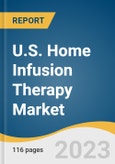The U.S. home infusion therapy market size is expected to reach USD 31.8 billion by 2030, according to the report. The market is anticipated to expand at a CAGR of 7.7% from 2024 to 2030. The growing geriatric population and increasing prevalence of disorders, such as cancer, immune deficiencies, Crohn's disease, infections, dehydration, nutritional deficiencies, multiple sclerosis, nausea, and vomiting are majorly driving the market’s growth. The increasing need for reduced hospital stays and the rising prevalence of chronic disorders in the geriatric population are driving the growth.
Growing cases of Hospital Acquired Infections (HAI) is another major factor driving the growth of the U.S. home infusion therapy industry over the forecast period. According to the U.S. Centers for Disease Control and Prevention, approximately 1.7 million admitted patients are affected annually by Healthcare Acquired infections (HCAIs) and around 98, 000 patients (1 in 17 patients) die due to the same. Due to this, the demand for home infusion therapy is increasing substantially.
Increasing innovations in home infusion therapy such as the incorporation of electronic healthcare records along with medical devices and infusion pumps are trending. It allows storage, retrieval, and alteration of medical records, making it easier for healthcare professionals and patients to track the improvements in a particular disorder.
Increasing patients’ preference for home healthcare since it is cost-efficient in comparison with hospital stays is an opportunity for the industry players to launch more innovative products. Also, the introduction of safety products will ultimately help the growth of the U.S. home infusion therapy market. The advent of COVID-19 boosted the home infusion market in the country as many key players like Baxter, BD, ICU Medical, and Option Care Health, Inc reported revenue increases for their home infusion products and services in 2020 and 2021. This trend is expected to further boost the market as numerous healthcare settings in the country are expected to permanently opt for home infusion services to decrease patient admission burden in hospitals and other healthcare facilities
Growing cases of Hospital Acquired Infections (HAI) is another major factor driving the growth of the U.S. home infusion therapy industry over the forecast period. According to the U.S. Centers for Disease Control and Prevention, approximately 1.7 million admitted patients are affected annually by Healthcare Acquired infections (HCAIs) and around 98, 000 patients (1 in 17 patients) die due to the same. Due to this, the demand for home infusion therapy is increasing substantially.
Increasing innovations in home infusion therapy such as the incorporation of electronic healthcare records along with medical devices and infusion pumps are trending. It allows storage, retrieval, and alteration of medical records, making it easier for healthcare professionals and patients to track the improvements in a particular disorder.
Increasing patients’ preference for home healthcare since it is cost-efficient in comparison with hospital stays is an opportunity for the industry players to launch more innovative products. Also, the introduction of safety products will ultimately help the growth of the U.S. home infusion therapy market. The advent of COVID-19 boosted the home infusion market in the country as many key players like Baxter, BD, ICU Medical, and Option Care Health, Inc reported revenue increases for their home infusion products and services in 2020 and 2021. This trend is expected to further boost the market as numerous healthcare settings in the country are expected to permanently opt for home infusion services to decrease patient admission burden in hospitals and other healthcare facilities
U.S. Home Infusion Therapy Market Report Highlights
- The infusion pumps segment held the largest revenue share compared to others due to the increasing use and efficiency in delivering required quantities of nutrition, medications, and other essential fluids
- The needleless connectors segment is expected to witness the fastest growth owing to various benefits, such as less risk of bacterial contamination and higher protection against needle stick injuries
- The anti-infective segment held the maximum revenue share in 2023 owing to its extensive use as an antifungal, antibiotic, and antiviral agent at home care
- Endocrinology is predicted to be the fastest-growing segment owing to the growing number of conditions associated with the endocrine system, such as thyroid and diabetes
Table of Contents
Chapter 1 Methodology and Scope
Chapter 2 Executive Summary
Chapter 3 U.S Home Infusion Therapy Market: Segment Analysis, By Product, 2018 - 2030 (USD Million)
Chapter 4 U.S. Home Infusion Therapy Market: Segment Analysis, By Application, 2018 - 2030 (USD Million)
Chapter 5 Home Infusion Therapy Market: Country Market Analysis, By Product, 2018 - 2030 (USD Million)
Chapter 6 Home Infusion Therapy Market - Competitive Analysis
List of Tables
List of Figures
Companies Profiled
- B. Braun Melsungen AG
- Baxter
- Caesarea Medical Electronics
- CareFusion Corporation
- Fresenius Kabi AG
- ICU Medical, Inc.
- JMS Co., Ltd.
- Smiths Medical
- Terumo Corporation
- Coram LLC
- Option Care Enterprises, Inc.
- BioScrip, Inc.
- BriovaRx Infusion Services
- Paragon Healthcare, Inc.
Methodology

LOADING...
Table Information
| Report Attribute | Details |
|---|---|
| No. of Pages | 116 |
| Published | November 2023 |
| Forecast Period | 2023 - 2030 |
| Estimated Market Value ( USD | $ 19.1 Billion |
| Forecasted Market Value ( USD | $ 31.8 Billion |
| Compound Annual Growth Rate | 7.7% |
| Regions Covered | United States |
| No. of Companies Mentioned | 14 |









